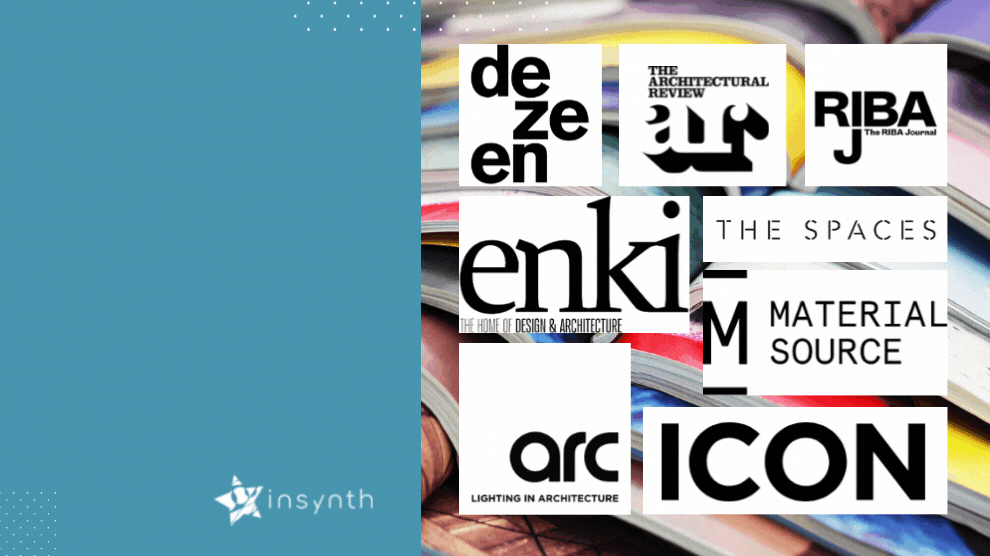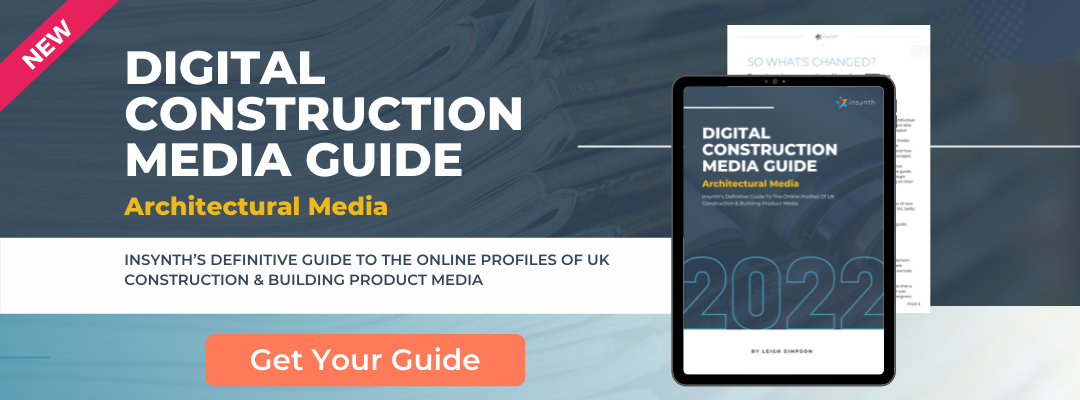6 min read
3 Must Have Digital PR Tactics For Architecture Magazines In The UK
![]() Ainhoa Rodriguez-Muguruza
:
10-Mar-2022 09:35:21
Ainhoa Rodriguez-Muguruza
:
10-Mar-2022 09:35:21

As architects and specifiers choose to go online when researching for products and solutions, building product brands are asked to understand the relevance of marketing strategies that involve SEO. If this is your case, you might have already noticed that SEO efforts might fall short depending on the goals that you have set for your company...
But there is a way of speeding up those results with Architecture Magazines!
Why Should Building Product Manufacturers Care About Digital PR
If you are not familiar with the term, the phrase digital PR englobes a set of services that are meant to work in combination with your marketing strategy. By focusing on your digital PR strategy, you can increase the number of times you feature on the digital site of industry publications. This practice, of course, resembles traditional PR, but acknowledges the digitalisation of the sector.
Digitalising PR brings additional benefits that go beyond simple advertising. Each time your brand features on the site of an architecture magazine or journal, your building product company will improve its authority, achieve credibility, and, most importantly, gain high-quality backlinks! The more backlinks you have, the better you rank on Google’s SERPs.
Because of its remarkable effects on SEO, your PR strategy should be aligned with your content production, as well as with your marketing strategy. Doing PR right will have a positive impact on the visibility of your website and increase the traffic that is directed to your site. But there are certain steps to follow to make sure that your digital PR efforts are as effective as they should!
In this blog post, I have gathered the three elements that you should look at before kicking off your digital PR strategy. So, you can see how these elements can be achieved, I have included different strategies and tactics that will allow you to have the information you need to make the right decisions regarding your digital PR strategy.
#1 Research Your Audience
Your PR efforts should have a very clear direction: that of reaching out to your audience and attracting them to your products. For that, you need to have a defined picture of who you are talking to.
In the construction sector, it is common that the same building product business has more than one persona, particularly if they cater to both architects and specifiers! In fact, not all specifiers look at solutions in the same way…
Learn About Your Clients
Most companies ignore that they already have access to an incalculable amount of data within their own database. If you are in the process of learning about the challenges and aims of those that purchase your products or services, you should consider asking directly those that have committed to such purchase.
A fantastic way of doing this is by interviewing past clients! You can ask them about what they were looking for when they first came across your solution and why they thought it was different from the rest. You can also gather demographic data, which will be particularly useful when setting up paid campaigns.
Define Your Persona
A solid PR strategy will have a deep understanding of the core challenges the specifiers that are interested in your solutions might be facing. The more research it is devoted to developing an all-encompassing persona, the more accurate your PR efforts will be.
You might discover that each persona prefers a specific publication! Architects, for instance, have remarkable attention to detail and value rigorous data over any other detail. Specifiers, in contrast, focus on function and how a product may stand out in the crowd.
Analyse Your Competition
If looking at your past client database and re-defining your persona falls short, there are still some tactics you can use to better understand your audience. One of these is to analyse your competitors! What are they doing and why are they doing it? Far from mimicking their strategy, your analysis should focus on what you can do differently and, most importantly, what you can do better!
When it comes to PR, architecture magazines might not be keen to feature two competitors on the same number and, if approached by two companies of the same sector, they will look at different elements to decide which one is worth featuring. Further through this blog post, I have summarised some of those elements that will allow you to have a flawless first impression.
#2 Know Your Industry Publications
Skimming through the post, you might have felt tempted to skip the first part and go straight to this section, in the hope that it will answer the million-dollar question… How do you know what publication to choose to focus your PR efforts in? While the answer might be straightforward, the process of getting that answer requires research being carried through!
Making the right decision will require you to know not only your target audience but also their habits, how they measure credibility, how they prefer reading their publications, etc. Once you have a clear picture of who your target is, it is time to start looking at architecture magazines! Should you look at every single publication within your sector?
Use A Digital Media Grader
A media grader refers to an objective assessment of the digital media within a sector or an industry. Its goal is to provide professionals within that area with an independent evaluation of the most popular digital publications of the sector so they can better adapt their PR strategy. And, as you might have guessed, the key is within the objectivity.
Did you know that, until Insynth published their 1st edition of the Architectural Media Grader back in 2019, there had not been an independent assessment of the different titles on the construction sector? Insynth were the first company to provide a holistic overview of the leading construction magazines focusing on the value a title could have beyond traditional advertising. You can download the 3rd edition of Insynth’s Digital Media Grader by clicking on the button below.
Go Specific
While reaching for leading publications might be tempting, when starting your PR strategy, going small is advised. You should look at niche publication that are focused, targeted, and that will truly value the information that you want to share with them. As time goes by and you grow your coverage on these publications, they will position you as a thought-leader within the industry.
This coverage will make you more competitive when it comes to featuring in larger publications but, even when doing so, you should research their publication trends and see whether they do any themed numbers. This is particularly common within the construction sector! Step by step, you will manage to increase your coverage within the industry.
Appoint A PR Liaison
Even in specialising in construction, people often forget that those managing PR requests for publications are journalists. While your copy should speak to architects and specifiers, your requests should appeal to journalists. Or, rather, a journalist. PR is about building relationships, and you should aim to establish a conversation with your PR contacts.
You can facilitate this conversation by appointing a PR representative within your team that should lead all the PR requests and consistently be in touch with journalists from target publications. This representative should also be the one tailoring the requests, making sure the language is appealing and catching and that the structure of the copy respects the publication guidelines.
#3 Press to Impress
Getting featured on the right architecture magazine should be a milestone, but not the main goal of your PR strategy. Taking into account the persona that has been the backbone of your PR efforts, it is essential that the content that the publication is directing people to is relevant, personalised, and catered to.
Should you simply direct them to your website? Certainly, you could. But here is why you should not! Each specifier will be looking for clear and easily available information. But they might not be looking for the same information!
Personalised Outreach
If architects and specifiers land in a generic website and if they are unable to gather the information that they need straightforwardly, they will likely be discouraged to specify you…
Ensure your content is consciously curated, your products clearly described, and your technical data easily available. Your website should gather all the information specifiers might need, guaranteeing that technical characteristics, performance data and details about the materials used are readily available within your site.
High-Quality Media
While different in many ways, specifiers will share their expectations when it comes to the quality of the media available to them, and so will the people assessing whether your brand fits in their publications!
The digitalisation of the industry required building product manufacturers to deliver their content through different channels and, more particularly, through the channels that their personas want to be reached through! Among the most promising content channels, video content has been reported as one of the most successful, allowing you to get your message to a greater audience in a professional, sophisticated, and yet accessible way.
Enable the Conversation
With all the elements mentioned above, one mistake could still hinder your PR efforts. You need to guarantee they can get in touch with you. If specifiers are not able to find what they are looking for but are impressed by your content, they might give you a second chance and reach out to you with some questions. You should get back to them immediately.
Specifiers value their time dearly and will not indulge anyone that dares to waste it. Make sure you get back to them in a timely manner and provide them with the right information without them having to insist too much.
About Insynth
At Insynth we deliver a predictable flow of leads, customers, and specifications for building product brands through our inbound marketing approach, proven to reach a technically demanding audience.
We use the latest marketing techniques such as construction inbound marketing, to equip building product companies to grow sustainability in this era of digital transformation.
As the only HubSpot certified agency to major in construction marketing. We have a proven formula of bringing a variety of functionalities together including CRM Implementation, Web Design, Sales Automation, SEO, and Email Marketing to achieve your ultimate aim: Growing your business and gaining new specifiers and customers.

